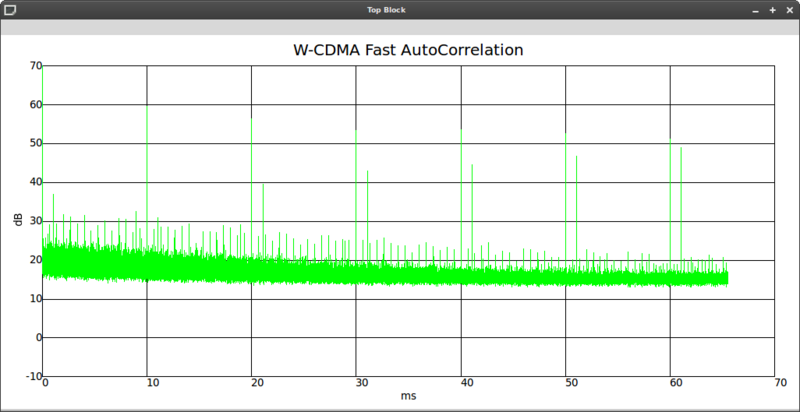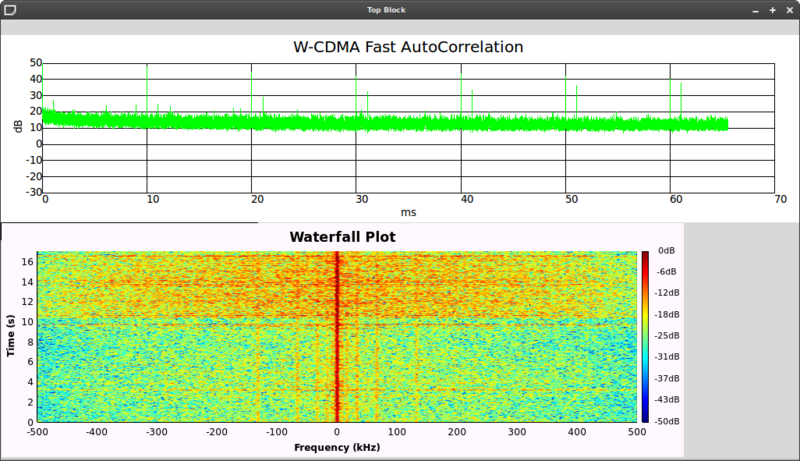Difference between revisions of "W-CDMA"
From SpenchWiki
| (3 intermediate revisions by the same user not shown) | |||
| Line 28: | Line 28: | ||
== Auto-correlation == | == Auto-correlation == | ||
| + | |||
| + | Calculated and displayed using the the [[Fast Auto-correlation]] block: | ||
* 3G UMTS at 2.1125GHz: | * 3G UMTS at 2.1125GHz: | ||
| Line 37: | Line 39: | ||
There is also a smaller peak at ~0.7ms, which should be the repeating slot of the pilot channel (if you count the peaks correctly, the 14th 'harmonic' will land precisely on the first strong 10ms peak). | There is also a smaller peak at ~0.7ms, which should be the repeating slot of the pilot channel (if you count the peaks correctly, the 14th 'harmonic' will land precisely on the first strong 10ms peak). | ||
| − | The peak at ~21/22ms requires further investigation, although it could be from an adjacent panel or cell (since they all use the same frequency). If you know, [http://spench.net | + | The peak at ~21/22ms requires further investigation, although it could be from an adjacent panel or cell (since they all use the same frequency). If you know, [http://spench.net/contact let me know]! |
* Telstra NextG at 842.5MHz: | * Telstra NextG at 842.5MHz: | ||
| Line 44: | Line 46: | ||
The above waterfall plot shows bursty traffic on the downlink. | The above waterfall plot shows bursty traffic on the downlink. | ||
| + | |||
| + | {{RF}} | ||
Latest revision as of 17:51, 19 July 2011
Specs
W-CDMA (Wideband Code Division Multiple Access) is used by the UMTS (Universal Mobile Telecommunications System).
| Property | Value |
|---|---|
| Modulation/Access scheme | W-CDMA |
| Channel bandwidth | 5MHz |
| Chip rate | 3.84MHz |
| Common pilot channel (CPICH) | Fixed-rate 30 Kbps, spreading factor (SF) 256 |
| Primary CPICH (CCPCH) | 14 slots in one radio frame |
| CCPCH slot | First 256 chips Tx OFF, then 18 data bits (20 bits/2560 chips in total) |
| CCPCH frame | 10ms total duration |
References
- A great PDF that deals with many technical aspects of the air interface.
Auto-correlation
Calculated and displayed using the the Fast Auto-correlation block:
- 3G UMTS at 2.1125GHz:
Strong peaks precisely on the 10ms grid line are indicative of the pilot channel.
There is also a smaller peak at ~0.7ms, which should be the repeating slot of the pilot channel (if you count the peaks correctly, the 14th 'harmonic' will land precisely on the first strong 10ms peak).
The peak at ~21/22ms requires further investigation, although it could be from an adjacent panel or cell (since they all use the same frequency). If you know, let me know!
- Telstra NextG at 842.5MHz:
The above waterfall plot shows bursty traffic on the downlink.
| ||||||||||||||||||||||||||||||||||||||||||||||||||||||||||||||||

